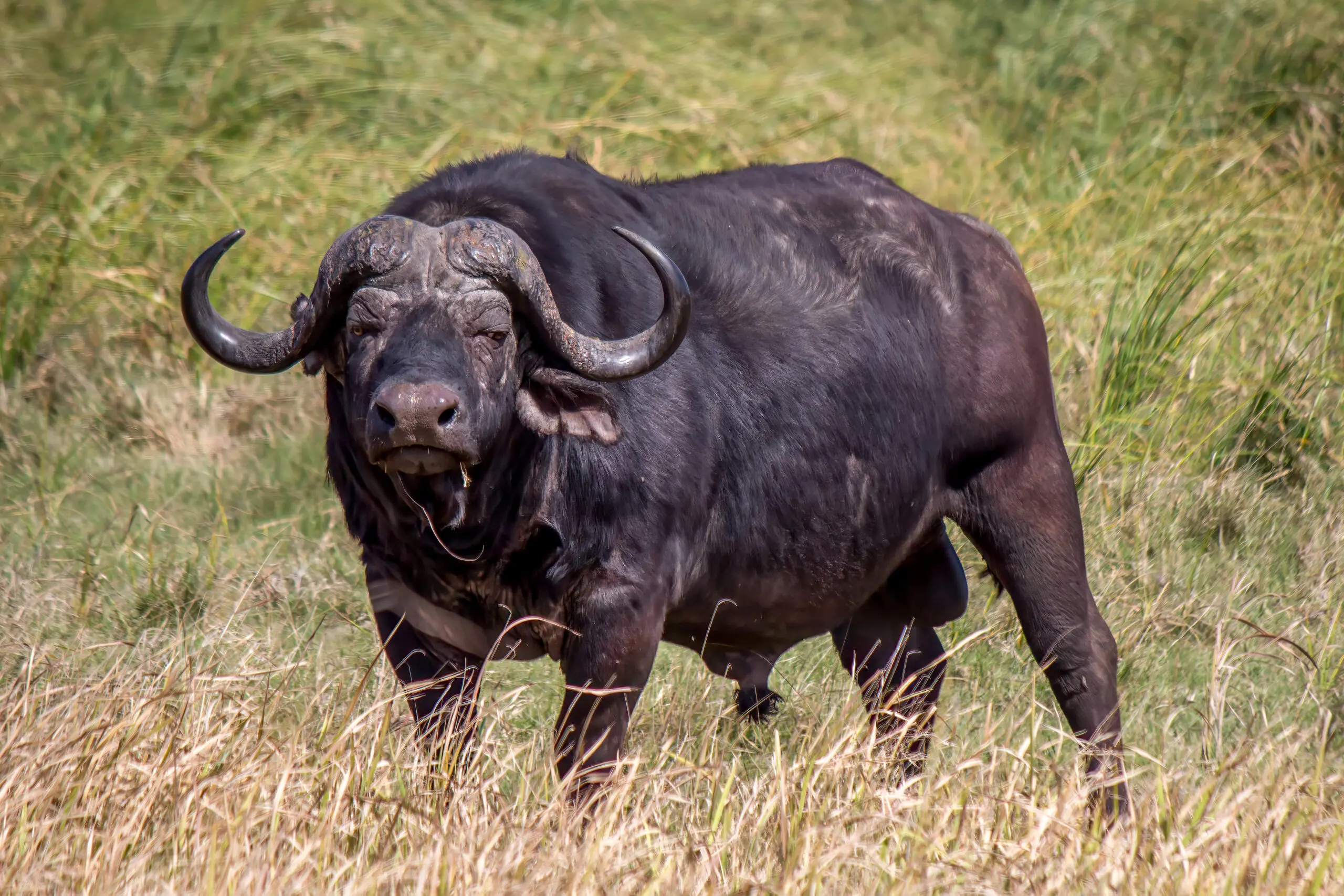The Lifespan of an African Buffalo: A Journey Through Time
The Lifespan of an African Buffalo. The African buffalo, scientifically known as Syncerus caffer, is a formidable and robust herbivore native to sub-Saharan Africa. This species is also commonly referred to as the Cape buffalo, African buffalo, or simply buffalo. It is known for its unpredictable nature, powerful build, and distinctive curved horns. The lifespan of an African buffalo is influenced by various factors, including environmental conditions, predation, and human activities.
Physical Characteristics:
African buffaloes are large and robust animals with a shoulder height ranging from 1 to 1.7 meters (3.3 to 5.6 feet). Bulls, or males, are generally larger than cows, or females. Both males and females have heavy, ridged horns that curve backward and then up, forming a sharp tip. These horns are used for defense against predators and are also a symbol of dominance within the herd.
Habitat and Range:
African buffaloes inhabit a variety of ecosystems, including grasslands, savannas, and forests. They are highly adaptable and can be found in a range of environments, from open plains to dense vegetation. Their range extends across much of sub-Saharan Africa, excluding deserts and rainforests.
Diet and Behavior:
Buffaloes are primarily grazers, feeding on grasses, herbs, and occasionally shrubs. They are known to be both diurnal and nocturnal, which means they are active during both day and night. Buffaloes form herds, ranging from a few individuals to several hundred members, providing protection against predators. These herds are led by dominant females, and older males may form bachelor groups.
Reproduction: – The Lifespan of an African Buffalo
The reproductive behavior of African buffaloes plays a crucial role in their population dynamics. The mating season, or rut, usually occurs during the rainy season when food is plentiful. After a gestation period of about 11 months, a single calf is born. Calves are vulnerable and often hidden in dense vegetation for protection. The herd provides a collective defense mechanism for the calves against predators.
Predation and Threats:
While African buffaloes are formidable and capable of defending themselves, they face threats from predators such as lions and crocodiles. Lions, in particular, are known to hunt buffalo, and confrontations between the two species can be intense and dramatic. Human activities, including habitat loss, hunting, and diseases transmitted by domestic livestock, also pose significant threats to the population.
Lifespan:
The lifespan of African buffaloes is influenced by various factors, and in the wild, it typically ranges from 15 to 25 years. However, factors such as predation, diseases, and human activities can significantly impact individual lifespans. Calves are particularly vulnerable during their early months, and mortality rates can be high. As buffaloes age, they may face increased challenges in maintaining their health and avoiding predation.
Life Stages: – The Lifespan of an African Buffalo
Calfhood (Birth to 6 months): African buffalo calves are vulnerable in their early days and heavily rely on the protection of the herd. During this stage, they learn essential survival skills, including grazing and recognizing danger. Calves are weaned at around 6 months but continue to stay close to their mothers for protection.
Adolescence (6 months to 3 years): As buffalo enter adolescence, they become more independent and start participating in group activities. They refine their social skills, often engaging in playful behavior with other young members of the herd.
Maturity (4 to 8 years): African buffaloes reach maturity at around 4 to 5 years, at which point they may start participating in mating rituals. Dominant males establish and defend territories, while females form cohesive family groups that provide protection against predators.
Prime Age (8 to 15 years): This stage marks the peak of an African buffalo’s life. During this time, individuals are in their prime physical condition, contributing actively to the herd’s dynamics. Males may compete for dominance, and females continue to bear calves.
Senescence (15 years and beyond): As African buffaloes age, they may experience a decline in physical prowess. Older individuals may be more susceptible to predation, and their reproductive capabilities diminish. Despite this, many African buffaloes can live beyond 20 years in the wild.
Factors Influencing Lifespan: – The Lifespan of an African Buffalo
Several factors influence the lifespan of African buffaloes:
Predation: Lions and crocodiles are primary predators of African buffaloes. The risk of predation is higher for young and elderly individuals.
Disease: Buffaloes are susceptible to various diseases, including bovine tuberculosis and foot-and-mouth disease. These diseases can significantly impact their overall health and lifespan.
Habitat and Food Availability: The availability of suitable habitats and food resources plays a crucial role in the longevity of African buffaloes. Droughts and habitat loss can lead to resource scarcity, affecting their health and survival.
Human Activities: Encroachment, poaching, and conflicts with humans pose significant threats to the African buffalo population. Conservation efforts and the establishment of protected areas are crucial for their survival.
Conservation Status: – The Lifespan of an African Buffalo
The conservation status of African buffaloes varies across their range. In some areas, they are abundant and considered of least concern, while in other regions, populations are declining due to habitat loss and poaching. Conservation efforts focus on protecting their natural habitats, managing human-wildlife conflict, and implementing measures to curb illegal hunting.
Remarks – The Lifespan of an African Buffalo
In conclusion, the lifespan of an African buffalo is shaped by a complex interplay of biological, environmental, and anthropogenic factors. Understanding and addressing these factors are crucial for the conservation of this iconic species, ensuring its continued presence in the diverse ecosystems it inhabits.








